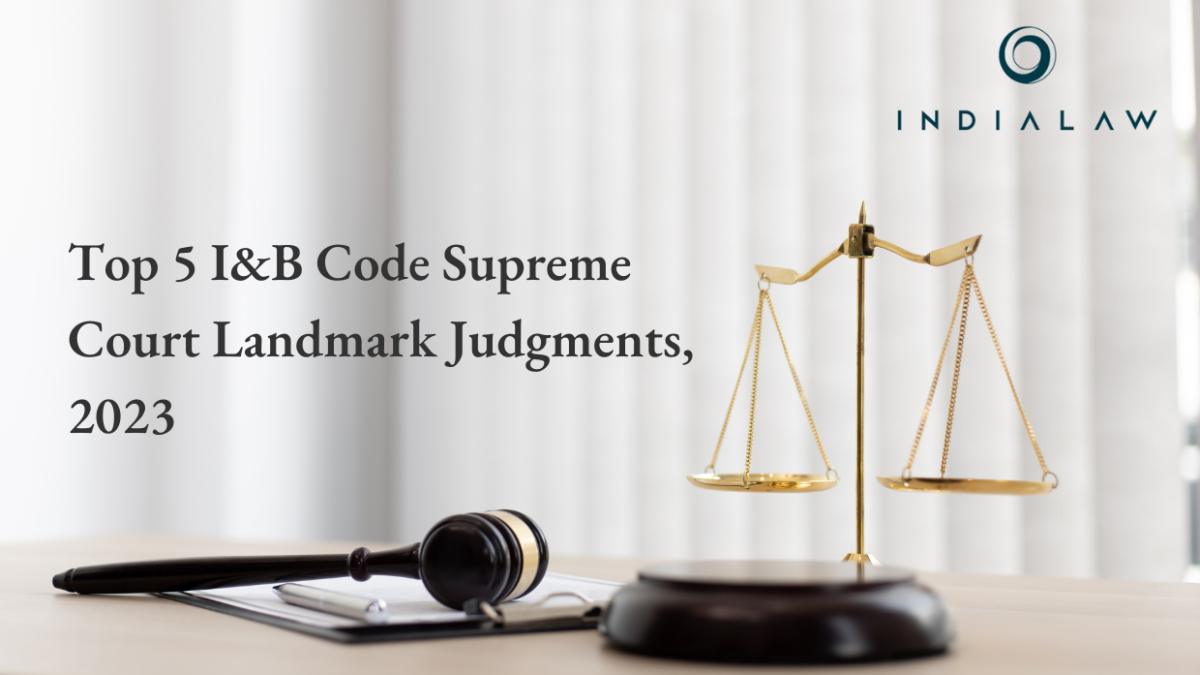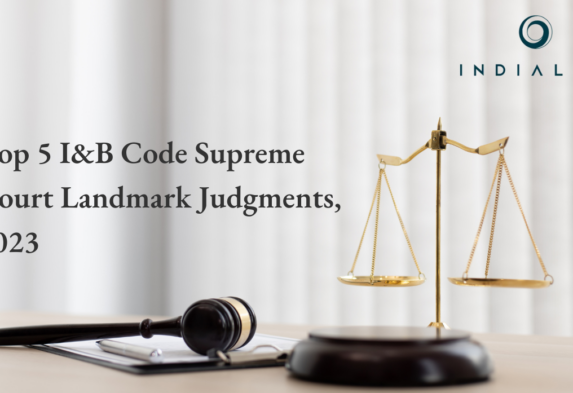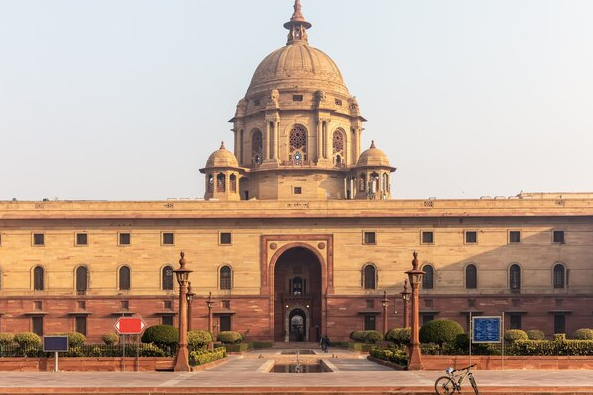Top 5 I&B Code Supreme Court Landmark Judgments, 2023


1. Supreme Court clarified position on limitation period barring operational claims arising out of multiple invoices
In March 2023, the Supreme Court (SC) division bench in M/s. Next Education India Pvt. Ltd. Vs. M/s. K12 Techno Services Pvt. Ltd.[1] held that when a petition is filed under Section 9 of the Insolvency and Bankruptcy Code, 2016 (I&B Code) based on several invoices wherein some of the invoices are time-barred, the Adjudicating Authority must consider invoices raised at least three years preceding the date of filing of Section 9 petition to determine limitation.
Facts of the case
M/s Next Education India Pvt Ltd (Operational Creditor) provided digital classroom services to M/s K12 Techno Services Pvt LTD (Corporate Debtor) between 12.03.2011 and 30.06.2017 and accordingly the Operation Creditor raised 187 invoices. In light of the non-payment by Corporate Debtor, the Operation Creditor issued Demand Notice under Section 8 of the I&B Code wherein date of default was mentioned as 12.03.2011 (the date of first invoice) and subsequently initiated proceedings under Section 9 of the I&B Code wherein the date of default was mentioned as 30.06.2017 (the date of last invoice).
However, the NCLT dismissed the Company Petition on the ground of the claim being time barred. The NCLAT after lengthy consideration decided that as the section 9 petition emanates from the Demand Notice issued under section 8, the sections have to be read conjointly. Therefore, the date of default shall in the matter be 12.03.2011 which is time barred as the limitation period expired on 12.03.2014. The said NCLAT order was challenged by way of the present appeal.
Decision of the SC
The SC set aside the orders of the NCLT and NCLAT and while considering the starting point of limitation as 12.03.2011 categorically stated that the NCLT should have taken into consideration the subsequent invoices raised up till at least three years preceding the date of the Company Petition rather than considering the starting point of limitation as 12.03.2011.
The SC has therefore settled the law regarding the determination of the limitation period where the Application under Section 9 of the I&B Code has been filed on the basis of several invoices.
2. Signatories/directors of Corporate Debtor cannot escape liability under Section 138 of NI Act
In March 2023, the SC in Ajay Kumar Radheyshyam Goenka v. Tourism Finance Corporation India Ltd.[2] dealt with the effect of the pendency of proceedings under the Insolvency and Bankruptcy Code 2016 (I&B Code) on the proceedings initiated under Section 138 of the Negotiable Instruments Act, 1881 (NI Act).
Facts of the case
Mr Ajay Kumar Radheshyam Goenka (the appellant) was the Promoter and Managing Director of M/s Rainbow Papers Ltd, sought loan of Rs 30 Crores from Tourism Finance Corporation of India (the respondent) to fulfil various corporate needs. To satisfy the obligations thus created, the appellant, on behalf of the accused company issued a post-dated cheque of Rs.25,47,945/- which was dishonored. Consequently, the respondent issued a demand-cum-legal notice under Section 138 of NI Act and thereafter filed a Criminal Complaint under Section 190 of the Code of Criminal Procedure, 1973 (CrPC) read with Sections 138, 141 and 142 of the NI Act.
Meanwhile, one M/s Neeraj Paper Agencies Limited filed an application under Section 9 of the I&B Code and accordingly the NCLT vide Order dated 12.09.2017 initiated Corporate Insolvency Resolution Process against the accused company, thus bringing moratorium into effect in the matter. In light of which, the appellant applied for exemption from personal appearance under the NI proceedings, which was rejected by the Metropolitan Magistrate. The appellant then appealed to the High Court but met with a similar fate. Hence, the appellant filed the present appeal.
Analysis of the SC
The nature of proceedings under the two statutes are different and would not intercede with one another. Under Section 14 of the I&B Code, the nature of proceedings that are kept in abeyance exclude criminal proceedings. The criminal proceedings under Section 138 of the NI Act arise due to default in financial debt, which classifies as ‘penal’ and not ‘recovery’ proceedings as one may undergo imprisonment or fine or both u/s 138 of the NI Act.
Section 31 or Sections 38 to 41 of the I&B Code, wherein debt can be extinguished would not ipso facto apply to the extinguishment of the criminal proceedings. If the proceedings under Section 138 of the NI Act had already commenced and if the company gets dissolved during the pendency of proceedings, the signatories/directors would face penal liability under the NI Act.
Decision of the SC
Where the proceedings under Section 138 of NI Act have already commenced, and during its pendency, the company gets dissolved, then the signatories/directors cannot escape the penal liability under Section 138 of the NI Act as what is being dissolved is the company and not the personal liability of the accused covered under Section 141 of the NI Act. Thus, the proceedings under Section 138 in relation to the signatories/directors shall continue in accordance with the law.
3. Supreme Court said that decision in Vidharbha Industries is an exception and not a rule
In May 2023, the division bench of the Supreme Court (SC), in M. Suresh Kumar Reddy vs. Canara Bank & Ors[3]. held that once the NCLT is satisfied that the default has occurred, there is hardly any discretion left with it to refuse admission of the application under Section 7 of the I&B Code.
Facts of the case
Syndicate Bank (now merged into Canara Bank) had sanctioned a secured overdraft facility and several bank guarantees to M/s. Kranthi Edifice Pvt. Ltd. (Corporate Debtor). Some bank guarantees were in favor of the State of Telangana. Subsequently, the State issued a letter to Syndicate Bank to extend the bank guarantees. The Corporate Debtor also wrote to Syndicate Bank for extending bank guarantees apprehending that the State might encash the bank guarantees since the contracts with the State were due for pre-closure.
Syndicate Bank rejected the proposal of the Corporate Debtor and asked it to repay the entire outstanding amount. The Telangana High Court restrained the Syndicate Bank from taking coercive steps under letters of invocation of bank guarantees. However, Syndicate Bank filed a Section 7 petition against the Corporate Debtor which was admitted by the NCLT. Aggrieved by the same an appeal was filed before the NCLAT by M. Suresh Kumar Reddy (the appellant), a suspended director of the corporate debtor, and the same was dismissed. The appellant then filed the present appeal before the SC stating that in Vidarbha Industries Power Limited v. Axis Bank Ltd.[4], it was held that the NCLT has discretion to reject or keep in abeyance a Section 7 petition if there is a good reason to do so.
Decision of the SC
The SC observed that the decision in Vidarbha Industries (supra) was given under a very specific set of facts, and itcannot be read and understood in contradiction to the view taken in Innoventive Industries Limited v. ICICI Bank and Another[5] and E.S Krishnamurthy and others v. Bharath Hi-Tech Builders Private Limited[6].
In Innoventive Industries Limited (supra), the scope of Section 7 was explained, and it was held that if the NCLT is satisfied there is a debt and default, it is bound to admit a petition under Section 7 of the IBC. The same was further reiterated in E.S Krishnamurthy and others (supra). SC concluded that in the instant matter, there were no good reasons for the NCLT to exercise its discretion and reject Section 7 petition.
4. Supreme Court clarified that Secured Creditors Are Entitled to Retention of Sale Proceeds of Shares Pledged by Corporate Debtor
In May 2023, the division bench of the Supreme Court (SC) in M/S. Vistra ITCL (India) & Ors. v. Mr. Dinkar Venkatasubramanian & Anr.[7] held that the Secured Creditor would be entitled to retain the sale proceeds i.e. shares pledged by Amtek Auto Limited (corporate debtor) under the Insolvency and Bankruptcy Code 2016 (I&B Code).
Facts of the Case
The corporate debtor approached M/S. Vistra ITCL (India) & Ors. (the appellants) to extend a short-term loan facility of Rs.500 crores to the corporate debtor’s group companies including M/s. Brassco Engineers Ltd. (Brassco) and M/s. WLD Investments Pvt. Ltd., (WLD) with the understanding that it would provide first-ranking exclusive security through a pledge over its equity shares in M/s. JMT Auto Ltd. (JMT). Several security trustee agreements were thus executed between the group companies and the appellant.
Subsequently, an application under Section 7 of the I&B Code to initiate proceedings against the Corporate Debtor was filed. Accordingly, a Resolution Professional was appointed, and approval of the Resolution Plan was sought before the Adjudicating Authority.
The appellants moved a claim as the Corporate Debtor’s secured creditor, which was rejected by the Resolution Professional. Consequently, the appellant claimed rights over the pledged shares. The Adjudicating Authority dismissed the application of the appellants, and they appealed before the NCLAT which was also dismissed on the finding that their claim as a secured financial creditor had been rejected previously. It added that as the Appellants did not pay any financial debt to the Corporate Debtor, they could not fall under the purview of the secured creditor.
Being aggrieved by the decision of the NCLAT, the appellants moved the SC.
Decision of the SC
The SC placed reliance on Anuj Jain Interim Resolution professional for Jaypee Infratech Ltd. v. Axis Bank Ltd.[8] and Phoenix ARC Pvt. Ltd. v. Ketulbhai Ramubhai Patel[9] judgments and concluded that the corporate debtor is not liable to repay the loans advanced, where separate agreements had already been executed by the lenders with Brassco and WLD.
The SC stated that the appellant, being a secured creditor was denied the rights u/s 52, 53 of the I&B Code for the pledge shares. The Court considered the definition of ‘security interest’ provided under Section 3(31) of the I&B Code, along with the nature of the pledge agreement. It added that Section 31 of the I&B Code requires the Adjudicating Authority to protect the interests of creditors who are not in the Committee of Creditors.
The SC discussed two solutions:
- To treat the secured creditor as a financial creditor of the corporate debtor to the extent of the estimated value of the pledged share on the date of commencement of CIRP; or
- To treat the Appellant as a Secured Creditor in terms of Section 52 read with Section 53 of the I&B Code.
The NCLAT’s order was modified partly by the SC recognizing the rights and obligations of the appellants as a secured creditor under Sections 52 and 53 of the I&B Code.
The SC while proceeding with second solution has made an equitable interpretation of Insolvency laws and allowed the application for Liquidation Proceedings during CIRP.
5. Supreme Court Clarified that Limitation Period for initiating CIRP and Lodging Claims during CIRP Based on Debt Recovery Certificate as Financial Debt
In October 2023, the Supreme Court (SC) in Tottempudi Salalith v. State Bank of India & Ors.[10] has affirmed its previous judgments and held that a DRT Recovery Certificate holder shall have, from the date of the Recovery Certificate, three years to initiate CIRP proceedings and twelve years to lodge a claim in CIRP, if pursued as a deemed decree.
Facts of the Case
Mr. Tottempudi Salalith (the appellant) was the managing director of the Corporate Debtor/ respondent No.2, Totem Infrastructures Limited. The Corporate Debtor defaulted on loans/facilities extended by several banks. The exposed Lenders issued a notice u/s 13(2) of the Securitization and Reconstruction of Financial Assets and Enforcement Security (SARFESI) and later initiated recovery proceedings against the Corporate Debtor before the Debt Recovery Tribunal (DRT). Three recovery certificates were issued by the DRT on 08.09.2015, 04.08.2017, and 17.10.2017, respectively.
Based on the Certificates, SBI applied under Section 7 of the I&B Code to initiate CIRP against the Corporate Debtor. While adjudicating, the NCLT considered the letter dated 29.01.2020 sent by the Corporate Debtor to the Union Bank and SBI as acknowledgement of debt and subsequently passed an Order dated 12.01.2021 admitting SBI’s CIRP application. The appellant challenged the NCLT’s admission order in the NCLAT. The NCLAT broadly agreed with the reasoning of the NCLT and sustained its judgment. Hence the present Appeal.
The Appellant’s Contention
- Pursuant to Section 18 of the Limitation Act, 1963, any acknowledgment beyond the period of limitation would not revive the right to sue.
- Section 238A of the I&B Code itself stipulates the application of the statute of Limitation on the I&B Code
- The date of default should go back to the date on which the loan account of the corporate debtor was declared a non-performing asset.
- Banks, having approached the DRT, were barred under the doctrine of election from approaching the NCLT for recovery of same set of debts.
Decision of the SC
The SC while addressing contention 1st and 2nd of the Appellant referred to the case of Kotak Mahindra Bank Limited v. A Balakrishnan and Another[11] (Kotak-I), where the financial creditor would be entitled to initiate CIRP within three years from issuance of the recovery certificate by DRT. That the NCLAT’s reasoning was procedurally wrong as the Corporate Debtor’s letter dated 29.01.2020 was issued post-filing of Section 7 Petition of the I&B Code. Therefore, in the absence of an amendment of pleadings, the NCLAT could not have taken such purported acknowledgment of debt to extend the limitation period.
The Court clarified that as per B. K. Educational Services Private Limited v. Parag Gupta & Associates[12] and Babulal Vardharji Gurjar v. Veer Gurjar Aluminium Industries Private Limited and Another[13], decision, the date of default shall be the date on which the limitation period starts ticking.
On the appellant’s 3rd contention, the SC referred to the case of Vashdeo R Bhojwani v. Abhyudaya Co-operative Bank Ltd & Anr.[14], where the date of recovery certificate was treated to be the date on which the time of limitation began to tick. R Bhojwani v. Abhyudaya Co-operative Bank Ltd & Anr[15], where the date of recovery certificate was treated to be the date on which the time of limitation began to tick.
When discussing the 4th Contention of the Appellant, the SC stated that the doctrine of election bars prosecution of the same right in two different fora based on the same cause of action.
However, regarding the instant appeal, the recovery proceedings before the DRT commenced in 2014. The I&B Code was not in existence then. Moreover, in Kotak-I it was held that the recovery certificate itself would give rise to a fresh cause of action to the Financial Creditor. The doctrine of election cannot be applied to prevent the financial creditors from approaching the NCLT for initiation of CIRP.
The SC concluded that what has been filed before the Authority is a composite application based on three recovery certificates, two of which were passed in 2017 and within the three years as postulated in Article 137 of the Limitation Act, and therefore Section 7 petition relating to these certificates is maintainable.
Regarding the third recovery certificate issued in 2015, the SC observed that it was issued under the Recovery of Debts and Bankruptcy Act, 1993 (1993 Act) and is also clothed with the character of a deemed decree as per the provisions of Section 19 (22A) of the 1993 Act and life of a decree as per Article 136 of the schedule of Limitation Act is twelve years for enforcement.
Therefore, as per decisions in Kotak-I and Kotak Mahindra Bank v. Kew Precision Parts[16], the SC opined that if the financial creditor wants to pursue a recovery certificate as a deemed decree, he will get twelve years to lodge a claim in I&B Code proceedings. and Kotak Mahindra Bank v. Kew Precision Parts[17], the SC opined that if the financial creditor wants to pursue a recovery certificate as a deemed decree, he will get twelve years to lodge a claim in I&B Code proceedings.
[1] Civil Appeal No. 1775 of 2021
[2] Criminal Appeal No. 172 of 2023
[3] Civil Appeal No. 7121 of 2022
[4] 2022 SCC OnLine SC 841
[5] (2018) 1 SCC
[6] (2022) 3 SCC 161
[7] Civil Appeal No. 3606 of 2020
[8] Civil Appeal Nos. 8512-8527 of 2019
[9] (2021) 2 SCC 799
[10] Judgement dated 18th October 2023
[11] (2022) 9 SCC 186,
[12] (2019) 11 SCC 633
[13] (2020) 15 SCC 1
[14] CIVIL APPEAL NO. 11020 OF 2018
[15] (2019) 9 SCC 158
[16] CIVIL APPEAL NO. 2176 OF 2020
[17](2022) 9 SCC 364




